Safety is always a worthy investment – especially when you get more education for your money.
From now until September 30th, the Mid-South OSHA Training Institute Education Center is offering a free OSHA elective course after you schedule any two OSHA-authorized courses. Mid-South is a consortium between Alliance Safety Council and Louisiana State University’s College of Engineering. It’s one of only 26 OTIECs in the U.S. and the only center located in Louisiana.
If you are already planning on investing in professional development soon, take advantage of this cost-savings opportunity and grab one of the OSHA elective courses we’ve listed below.
OSHA 521 – OSHA Guide to Industrial Hygiene
OSHA 2045 – Machinery & Machine Guarding
OSHA 2225 – Respiratory Protection
OSHA 2455 – Safety and Health Management Program
OSHA 3085 – Principles of Scaffolding
Consider the top 10 OSHA violations in 2022. Respiratory protection, scaffolding and machine guarding were included in the list of top 10 OSHA violations and could be timely electives for you and your team.
This week, during Labor Right Week, take time to encourage mutual respect and collaboration within your organization.
Not sure where to start? Click here to view available resources from the U.S. Department of Labor.
Have questions? Call 1-866-4-USA-DOL for assistance. Support is available in English, Spanish and other languages.
We also encourage you to share the infographic below with your teams.
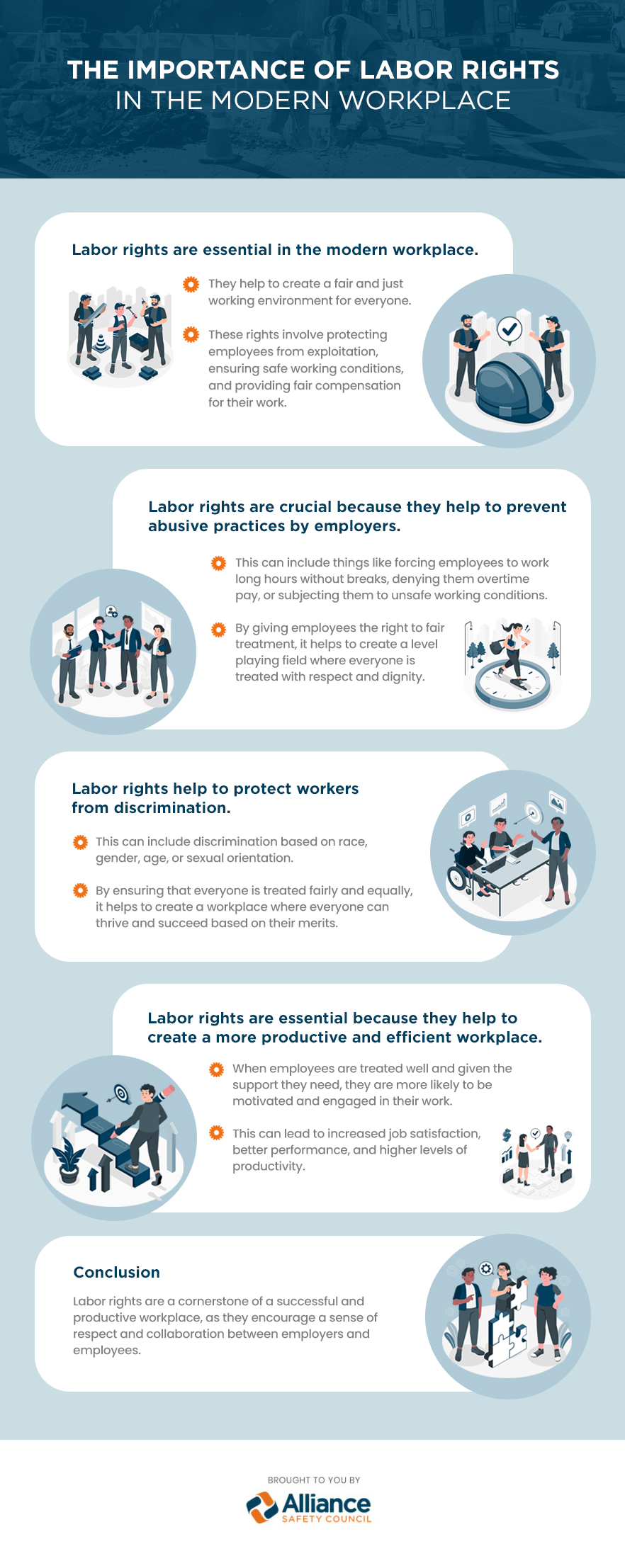
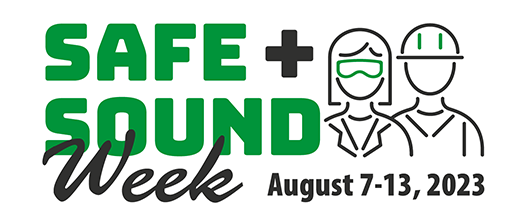
Safety in the workplace is critical for several reasons. First, it helps prevent accidents and injuries, which can cause physical harm to employees and result in fines and legal consequences for the employer. Second, a safe work environment promotes productivity and reduces the number of sick days taken by workers. It can also help improve morale and job satisfaction, leading to lower turnover rates.
To achieve safety in the workplace, it’s important to follow certain guidelines, i.e., ensuring all employees have received adequate training on procedures and protocols. This includes training on the proper use of equipment and machinery, as well as emergency procedures in case of accidents or incidents.
Additionally, it is important to regularly assess and address potential hazards in the workplace, such as faulty equipment or unsafe working conditions. Encouraging open communication between workers and management can also help to identify and address safety concerns.

Let OSHA know you are participating this year by pledging now.
Identify activities and events to plan and promote.
After completion of your events, you can download a certificate and virtual challenge coin to highlight your organization’s efforts.
Alliance Safety Council, one of the nation’s largest occupational safety and workforce development providers, has partnered with Hard Hat VR, a veteran-owned business and leader in developing and delivering immersive training options to multiple industries.
This partnership between Alliance Safety Council and Hard Hat VR marks an exciting step forward for businesses looking to provide their employees with cutting-edge training experiences with virtual reality and web-based 3D safety modules.
Web-based 3-D courses are available now! To view these courses, click here and search the term “Hard Hat VR” on the left-hand side of the page.
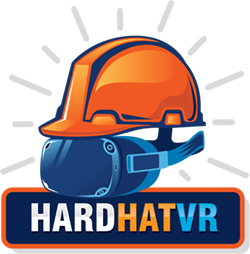
We are thrilled to be partnering with Hard Hat VR. This collaboration will bring impactful and immersive training resources to our members, revolutionizing the way industry approaches training. With the addition of HardHat VR’s content library, Alliance’s offering will be more engaging than ever before.
– Kathy Trahan, Alliance Safety Council President/CEO
Hard Hat VR CEO Jeff Dotson said, “We are excited to partner with Alliance Safety Council to bring our VR training solutions to a wider audience. With Alliance Safety Council’s reputation for providing the best possible training resources to businesses, we are confident that our collaboration will bring a new level of safety and productivity to workplaces across the country.”
Headquartered in Baton Rouge, LA, Alliance Safety Council provides web-based, virtual instructor-led, and in-person safety training, as well as technology and records management services.

On Oct. 11, Alliance is hosting an engaging and interactive program – the Professional Mastery & Assessments Certification (PMAC) – led by Consulting Resource Group International (CRG)’s Ken Keis.
The three-day program allows professionals to instantly increase their credibility and effectiveness with others, and how to teach others to do the same, through CRG’s performance support tools. These tools help measure stress and health practices, self-worth, core values, and sales and entrepreneurial success.
Ken Keis, Ph.D., is a foremost global authority on behavioral assessment strategies and processes, and an expert in leadership, purpose and wellness. He’s written four books, 13 assessments, 40 business training programs and several online courses. Ken is an expert in helping individuals, families, teams and organizations realize their full potential. In the past 33 years, Ken has conducted over 10,000 hours of coaching and consulting.
Over 1 million people in 30 countries have utilized CRG’s performance support tools and processes to help build teams that live, lead and work with purpose! Clients include Boeing, Chrysler, Honda, AT&T, and several universities and career centers. Learn more about CRG.
Thanks to federal grant funding, all materials and instruction for this virtual class are available AT NO COST – which allows Alliance Safety Council to offer this training FREE OF CHARGE to our members.
The class will be held via Zoom on Wednesday, June 29, 7:30 – 11:45am. Attendees will learn how to identify and manage infectious disease hazards on construction sites and also how to protect the public when performing construction in a healthcare setting.
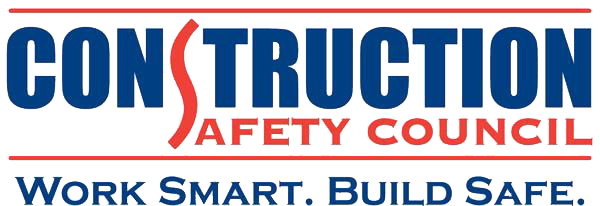
The half-day virtual training will focus on exposure to infectious diseases, including COVID-19, in small businesses. Oftentimes, unseen hazards present dangers to workforce health and safety that are more threatening than physical hazards.
Participants will gain knowledge about measures to prevent the spread of harmful airborne and bloodborne contagions. The science may be complicated, but the solutions are easy to include in a company exposure control plan.
By the end of this course, participants will be able to:
Click here to learn more and register.
Utility companies understand the importance of having properly oriented contractors on their worksites. It helps you:
The challenge: finding the right contractor orientation system that will close all the necessary knowledge gaps while requiring less on the part of the utility owner.
What do you look for? How do you know when you’ve chosen the right solution? Use this contractor safety orientation checklist as you choose which system to mandate on your worksites.
Not all contractor orientations are equal. Many aren’t standardized or compliant – and often, they’re complicated to create, implement and maintain. You want to outsource your safety orientations to a system with the following benefits.
Implementing a better safety orientation shouldn’t be a big undertaking. Find a provider that offers expert support for the entire implementation process, end-to-end. A system that comes with initial setup, contractor communications and call center support (even after hours).
Long story short, you don’t need ample time and resources to make your worksites safer. The right system and support should do it for you.
The priority of the workplace today is health and safety – and remote whenever possible. While in-person kickoffs and training are valuable, online orientation platforms can offer a streamlined approach to contractors’ onboarding conveniently and safely.
Your contractors don’t have to be tech-savvy to go through an online orientation. For instance, many PowerSafe students take the orientation right from their phones, with multiple support resources they can refer to. Our support team is there for individual help and provides detailed tutorials you can distribute prior to launch.
As an example of a resource contractors receive, read our PowerSafe Mobile Walkthrough infographic.
Safety programs shouldn’t break the budget. In fact, they should produce long-term cost savings.
Properly oriented contractors:
When it comes to jobsite safety orientation, your only role should be to mandate the course for your worksite. The rest should be on the contractors to complete, and on the orientation system provider to implement and maintain it.
Without exhaustively auditing contractor safety certifications, you should be able to trust that contractors are getting the knowledge they need and that their records are automatically verified, managed and always secure.
Mandate contractor safety orientation that makes your life easier through:
You’ve been in the business a while, which means you probably have other educational programs in place. A fresh contractor safety orientation doesn’t have to be a complete overhaul. In fact, it should complement your existing safety courses and help you leverage your safety coordinators on the most important tasks in the field.
Keep your in-person kick-off meetings and training that help your team stay connected, while eliminating redundancy and making sure contractors show up ready for their first day.
The utility industry faces unique challenges and risks when it comes to ensuring safe worksites. Therefore, you would expect there to be proper orientation curated for the utility industry specifically.
You should also be looking for customization. You may already have the content and site-specific standards outlined, so your orientation provider should take that and apply it to the industry-developed curriculum.
Often, contractors sit through inconsistent orientations as a result of instructor preferences, other participants or other variables. Look for consistent safety orientation options that put all contractors through the same verifiable, OSHA-compliant material.
Worksite safety is all about reducing risk, costs and liability. With online contractor orientation, the utility owner can verify that students have been exposed to and exhibit an understanding of the materials presented.
This means that if an injury were to occur and a company gets subpoenaed, they have training records they can provide – offering the utility owner protection.
Alliance Safety Council, one of the nation’s largest occupational safety and workforce development providers, has developed ReadyDriver™, an online truck driving theory program, meeting new Federal Motor Carrier Safety Administration (FMCSA) requirements for commercial driver’s license (CDL) applicants that go into effect February 7, 2022.
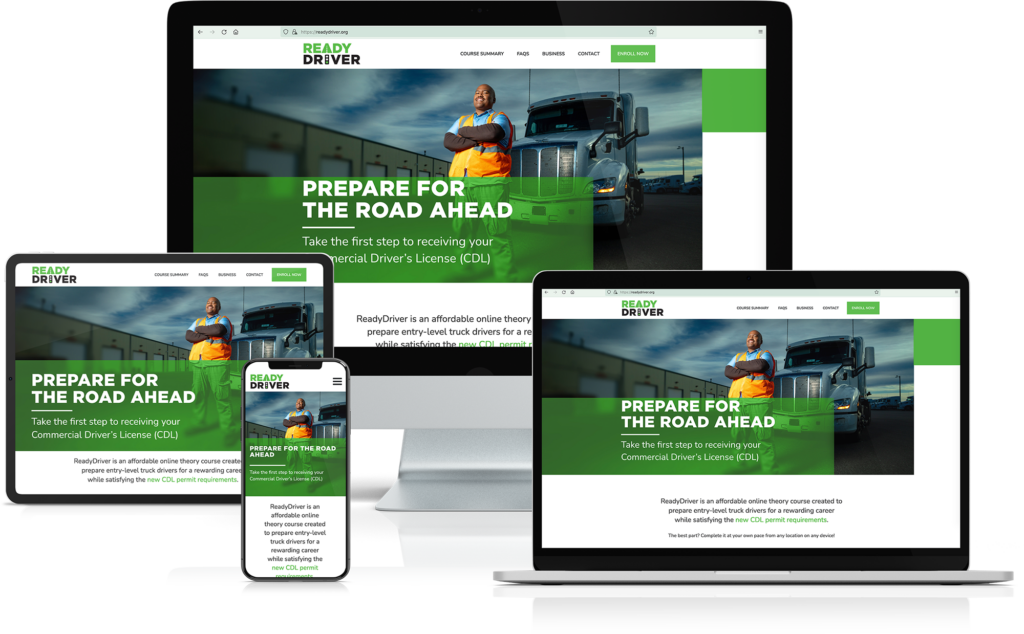
ReadyDriver™ is a comprehensive online theory program that participants can complete from anywhere, on any device at their own pace. The program was developed for driving schools, companies that train drivers internally, and individuals seeking a CDL for the first time.
This online theory training program utilizes identity authentication technology, ensuring the highest level of integrity and legal defensibility. ReadyDriver™ automatically submits results to the FMCSA, streamlining the licensing process and eliminating the need to manually submit results.
Local driving school Diesel Driving Academy supported ReadyDriver™ course development as subject matter experts. Combined, Alliance Safety Council and Diesel Driving Academy have over 120 years of experience preparing workers for their careers. These organizations are dedicated to helping solve the driver shortage and logistical challenges our community and country face today, while ensuring safety across all industries.
With the new regulations for entry-level drivers and continuing regulatory and compliance issues facing the industries we serve, we’ll continue to work on mitigation of those issues. We’re committed to investing in improved technology solutions and the latest training techniques, such as micro-learning and immersive capabilities, to increase trainee engagement and, more importantly, retention. This new requirement is an excellent step forward in protecting not only truck drivers but also other motorists on the road.
– Kathy Trahan, Alliance Safety Council President/CEO
Alliance Safety Council is an online Class A theory training provider in the Federal Motor Carrier Safety Administration’s (FMCSA) training provider registry (TPR).
Take the first step to receiving your Commercial Driver’s License (CDL).
For 20 years, the Certified Occupational Safety Specialist (COSS) program has helped workers master the core competencies necessary to be successful in the occupational safety and health field.
Let’s have a look at the past 20 years.
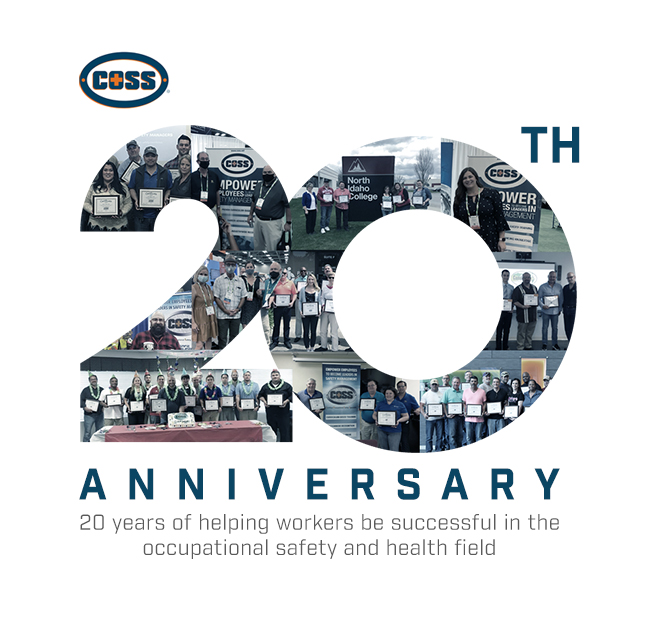
It was realized that there wasn’t a comprehensive training package for practitioners in the field of safety and health. Too often, employees become responsible for safety in an organization, but is then given no guidance as to how to complete their job duties.
It was with this in mind that the forerunner of COSS, Certified Safety Coordinator (CSC), was conceived. The first class was held in November 2001.
After taking the COSS class, I feel 100-percent more confident and knowledgeable in my new position.
– Joe Eubanks, H&E Equipment Services
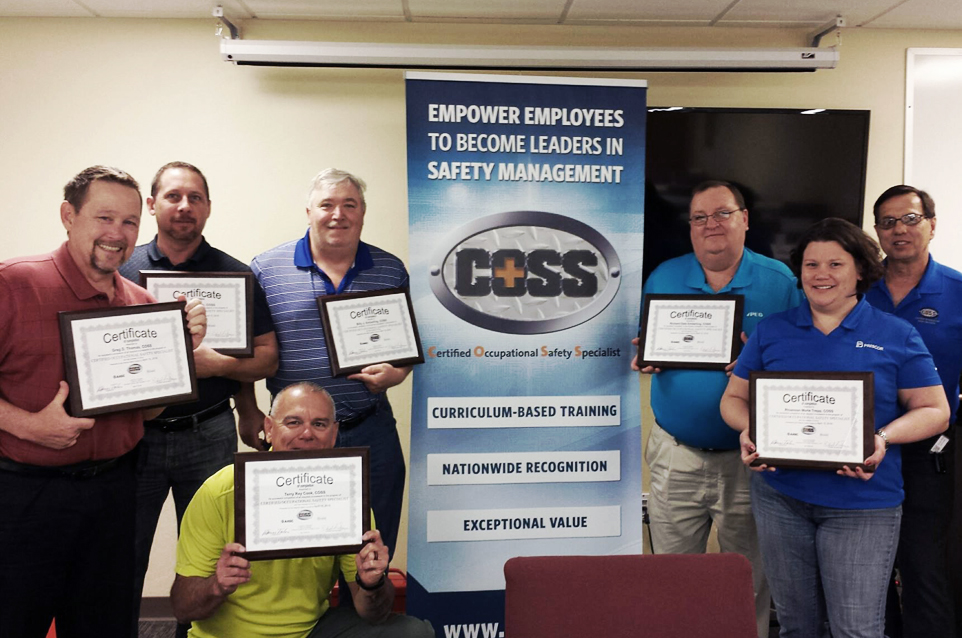
The CSC course was built around four key elements:
These elements were all integrated to address the identification and mitigation of hazards in the workplace by relating them to regulatory standards.
It soon became apparent that some things would have to change due to several realizations, such as:
In late 2002, the CSC program was overhauled. New course objectives were written, a new textbook was selected, and the student workbook was revised. Additionally, tests and quizzes were developed, PowerPoint presentations were created for every element of the training, and a comprehensive instructor guide was developed. Additional exercises and activities, such as compliance moments, were incorporated into the program.
…the best training course I’ve attended in a long time.
– Paul Amy, BP Amoco
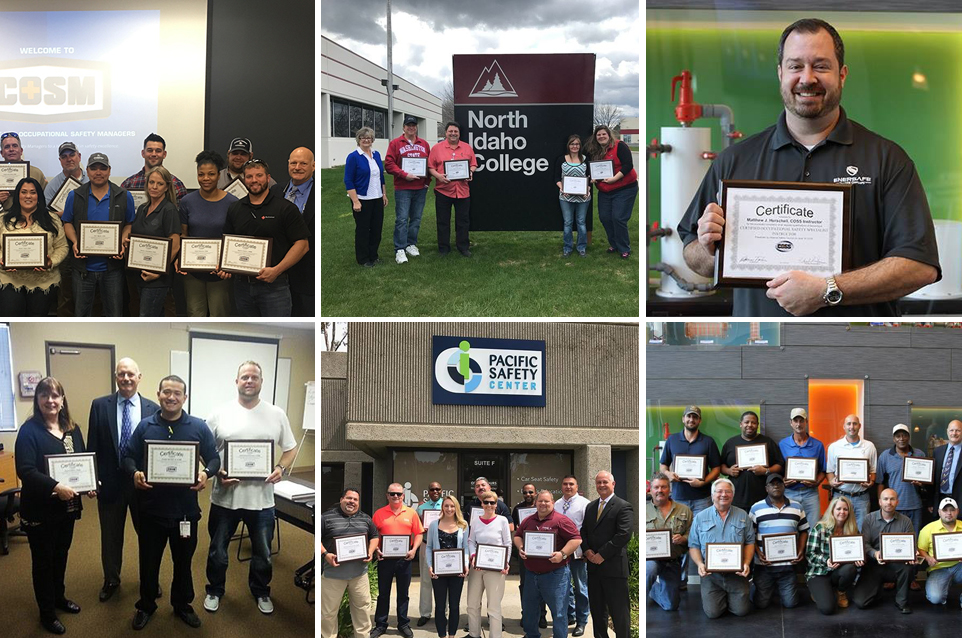
After several months of ongoing dialogue, many suggested improvements were incorporated into the program. Classes continued at a rate of 6 per year through 2003.
I am much better equipped to recognize, control and prevent hazards. Great course. A must for any technical professional.
– Brenda Maris, Georgia Gulf Corp
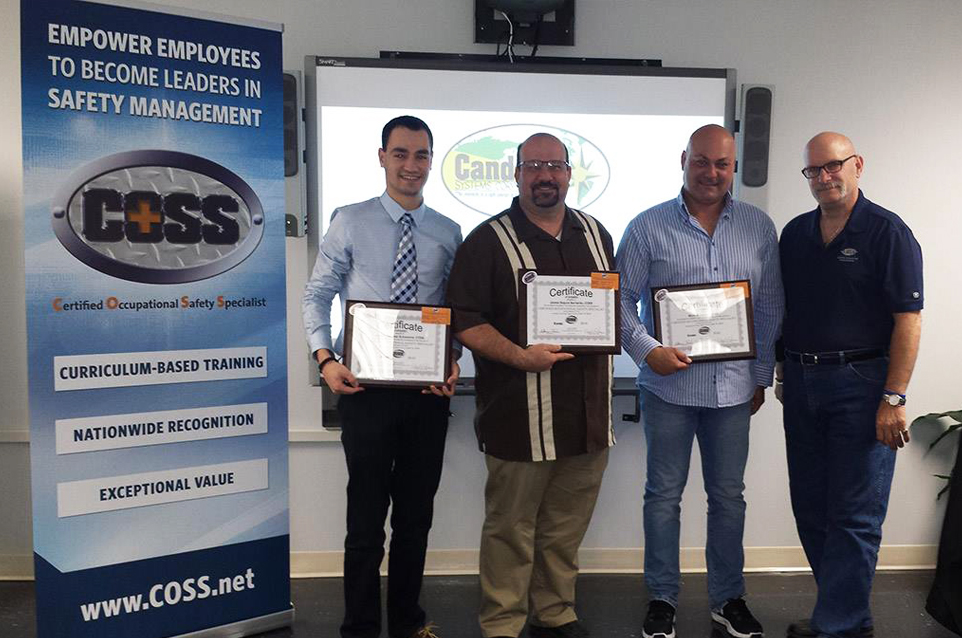
These ATPs included Louisiana State University’s Department of Continuing Education; Louisiana State University’s School of Construction Management; the Pacific Safety Council in San Diego, CA; the Houston Area Safety Council in Houston, TX; the Great Lakes Safety Training Center in Midland, MI; and the Tennessee Valley Training Center in Decatur, AL. These partners began hosting classes at their locations and, in 2004, there was a total of 13 COSS classes held across the country.
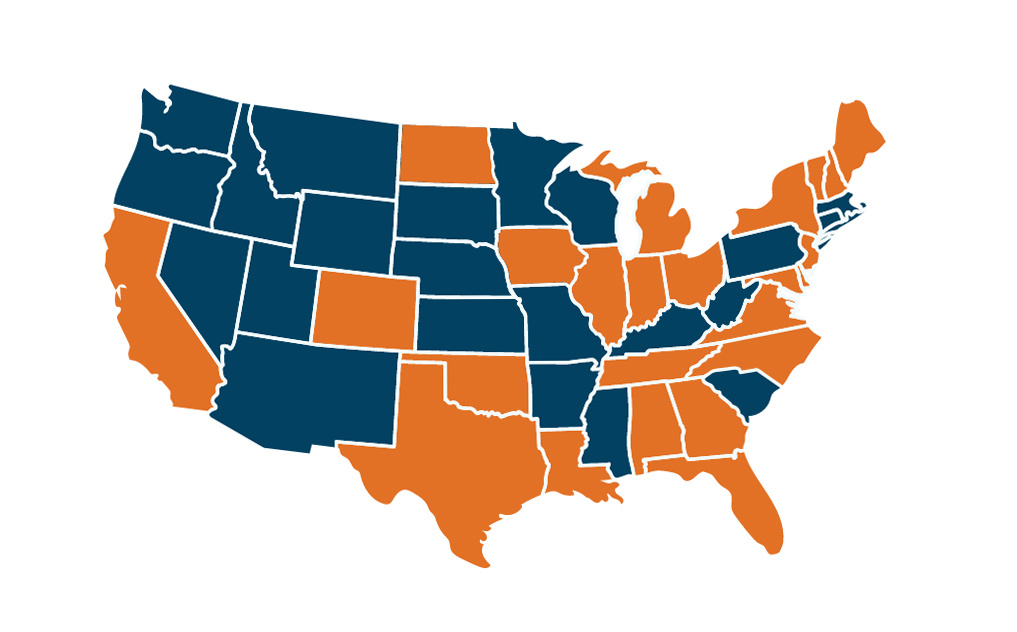
Additionally, recognition by the American Council for Construction Education (ACCE) was granted in July 2005.
COSS is a great in-depth, knowledgeable, intense course to take. I feel I’m ready to help any company with all of their occupational safety needs after taking this quality course!
– Ron Briscoe, Deleon & Associates Oil & Gas
The informational video below was filmed in 2014 at a COSS course and contains sound-bites from students that attended the class.
In 2020, COSS launched a new website and held its first virtual program. Virtual COSS Series classes are offered in real time during live classes with expert instructors. Virtual courses feature the same innovative and rigorous curricula as in-person courses.
I am proud to have been part of the first virtual COSS class. It is a great program.
– James Summers, COSS graduate, via Facebook
COSS is continually working on improving its website to give prospective students and graduates the best experience possible.
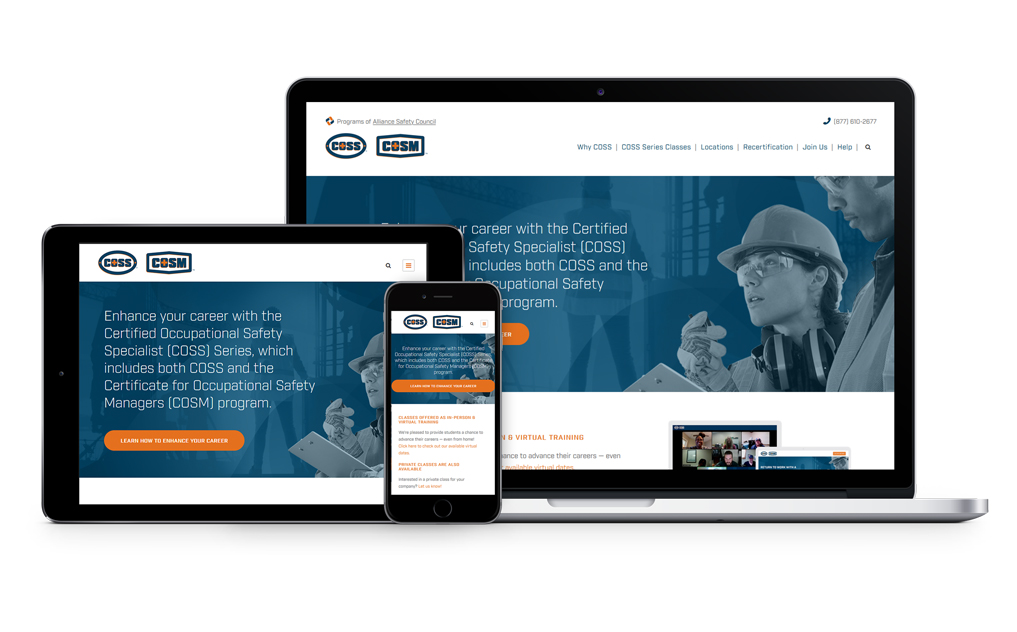
With 14,500 COSS graduates from 48 states and 30 countries impacted by the program, COSS continues to grow and add additional ATPs across the U.S. and internationally.
The best learning experience in my 13+ year safety career.
– Stephen Chapman, Entergy
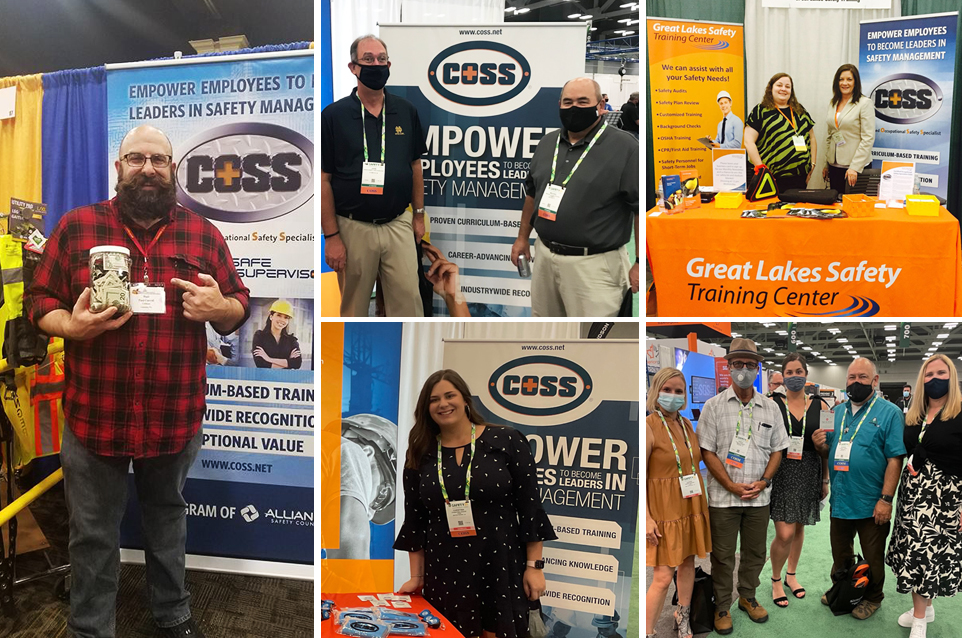
Look no further than COSS, a curriculum-based program that caters to the needs of beginning safety practitioners, as well as experienced safety professionals in need of a refresher.
Falls from ladders are a leading cause of workplace fatalities. By following the basic rules of ladder safety and having a fall prevention plan in place, serious accidents can be eliminated or substantially reduced.
Here are five basic rules for ladder safety.
It is important to choose a ladder that has the proper load capacity for the job. Consider your own weight as well as the weight of your equipment, tools and materials. The ladder must be long enough to work from without using the top 3 feet.
Before use:
After use:
Ladder placement is important. When using a portable ladder, make sure it is placed on a level surface and that it has non-slip base pads. Protect the base of ladder with a barricade in high traffic areas. Be sure to lock or block any nearby doors that open toward you. If you’re using a stepladder, ensure that it is fully open before use.
A straight ladder should be placed at a four-to-one ratio, which means that the base should be 1 foot away from the wall or vertical surface for every 4 feet of height to the point of support. When climbing onto a roof or platform from a ladder, the ladder must extend at least 3 feet above the edge and be tied off at the top.
Stay near the middle and face the ladder while holding onto the side rails with at least one hand when climbing or descending. Carry your tools on a belt or hoist and always keep at least three limbs on the ladder. Look for overhead power lines before handling or climbing a ladder.
FFor easy reference, we’ve created this handy infographic on ladder safety.
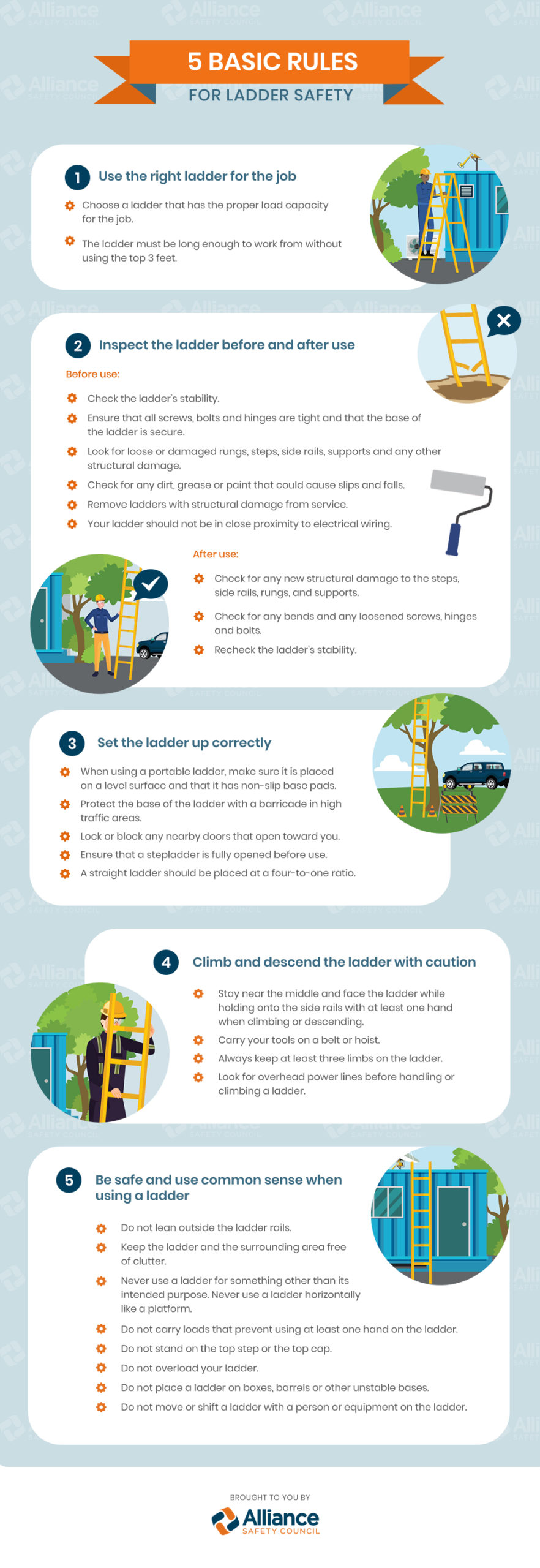
Source: https://safety.nmsu.edu/
Learn how the regulatory, legal and mitigative value of training can be maintained when training is delivered online.



Falls are the leading cause of death in the construction industry. By having a fall prevention plan in place and using the correct safety equipment, serious injuries and fatal accidents can be prevented. Here are five ways for workers and employers to identify and prevent common fall hazards on a construction site.
Here are five ways for workers and employers to identify and prevent common fall hazards on a construction site.
It is important to inspect all safety gear before starting a job. Inspect your harness, lanyard, and anchorage point before each use.
Employers must provide sufficient fall protection and safety equipment to workers working six feet or more above lower levels. These workers are at risk of serious injury or death if they should fall.
Employers must have a fall prevention plan in place when working from heights to ensure worker safety. This includes how the job will be completed, the various tasks involved, and the safety equipment needed to complete each task.
When estimating job costs, employers should include all the necessary safety equipment and tools, as well as a plan to have it available at the construction site.
It is important that workers use the right kinds of ladders, scaffolds, and safety gear. Workers using personal fall arrest systems (PFAS) while doing roof work must wear a harness that ties off to the anchor. The PFAS must be fitted properly and should be regularly inspected for safe use.
Employers must train all workers on proper set-up and use of equipment on the job, as well as recognizing safety hazards.
By incorporating these basic safety principles, your workers and construction site will be safer and more efficient. View our available courses section to see various courses on fall safety.
Stop falls. Save lives
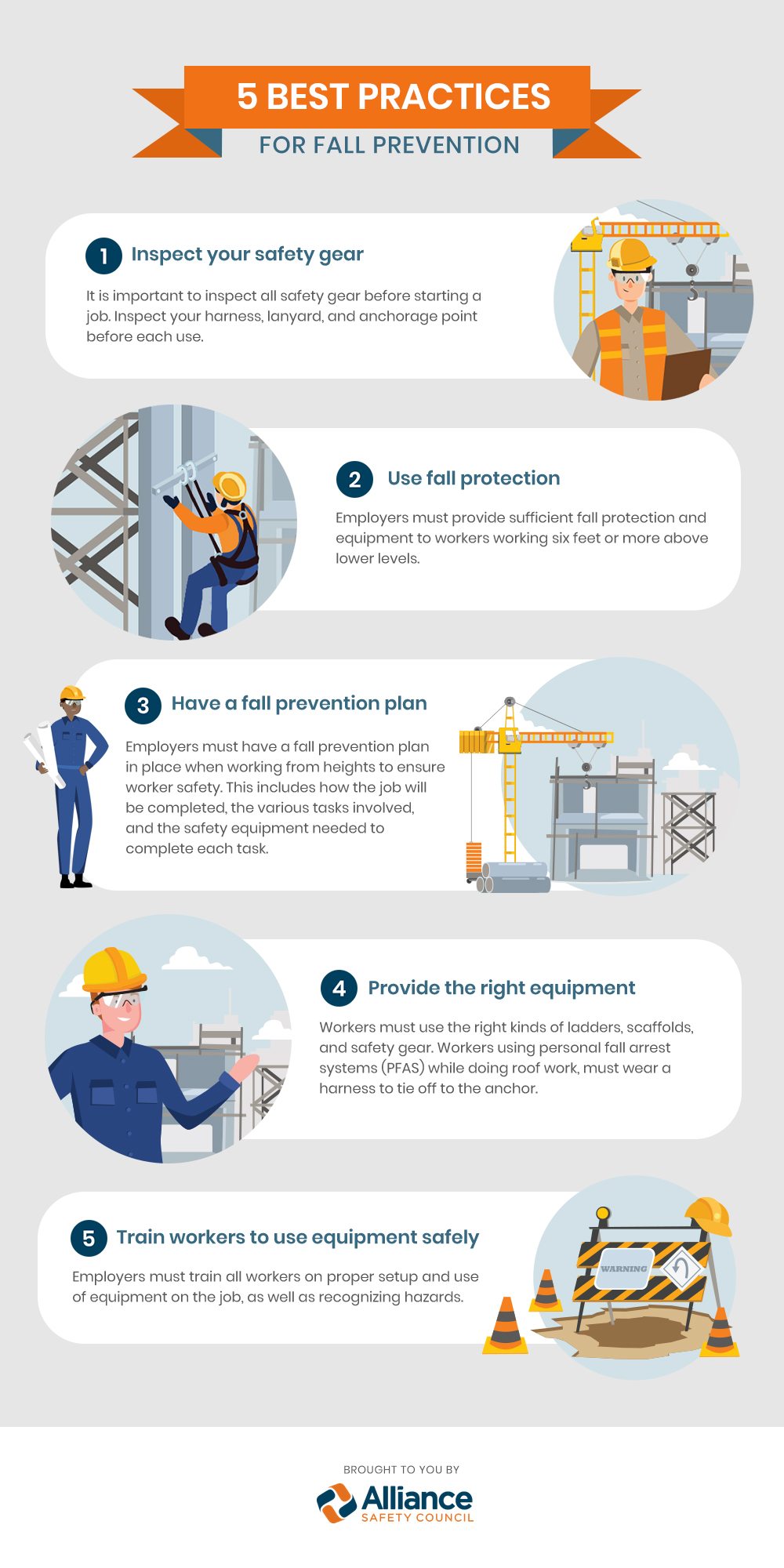
Source: https://www.osha.gov/stop-falls
Each year, Alliance helps over 270,000 workers become job-ready with best-in-class training and technology solutions. In every state and around the globe, Alliance delivers timely content with one goal in mind: To create a workplace that’s safer and a workforce that’s more productive.